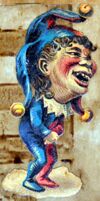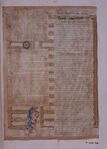< The British National Association of Spiritualists (continued from page 4-98) >
ticular spirit thus presenting himself, becoming convinced of his moral consciousness, and believing his statements. But for the public it would seem to be waste time to attempt to gain evidence of personal life after death from such phenomena. It is best, surely, to view them simply as phenomena, without vexing ourselves with complicated questions of identity, or endeavouring to make the facts carry conclusions which they will not bear. As phenomena, they are presented for investigation: of their objective reality no doubt can exist in the mind of any informed man. But beyond that all is darkness, illumined only by fitful gleams of more or less probable speculation.
“The thing itself is there, but by what method it has been formed, what its source and object, whether it is an animated statue or a spiritual being encrusted with molecules of matter? whether, if so, it be of our race or not, and, most important of all, what is the power that lies behind it? what the formative intelligence that can create and destroy in this wise? These are questions which remain for solution, and which will be solved, not by wild guesses or enthusiastic speculations, but by sober, patient, and protracted investigation.”
At the close of the reading of the foregoing paper, the chairman expressed the opinion that cabinets must be abolished before much progress in the knowledge of the nature of the phenomena can be made. Perhaps the awkward movements of some of these forms were due to their possessors coming suddenly within the influence of gravitation.
Dr. Wyld said that Mr. Colley had stated that he had seen these forms grow from the size of a doll to that of a man, which would tend to prove that the materialised figures were automata produced by spiritual force. If so, as automata, their outward appearance gave no proof of identity; their producers might be able to copy features, and “to deceive the very elect.” Mr. Colley had told him that the clothes of Dr. Monck rotted quickly; might this not be due to Some of their constituent particles being used in the processes of materialisation, and afterwards returned to him somewhat, say, in the condition of shoddy? (Laughter.)
Mr. Charles Blackburn, of Didsbury, stated that Miss Kate Cook had been giving seances in his house, and that one of her spirits had told him that the spirit drapery was not brought into the room in the condition in which it was shown to the sitters, but it was carried in a “fluidic” state. He then described the seance, the details of which he had previously published in The Spiritualist.
Mr. Mawson and Mr. Ashton complained that in consequence of the platform being placed at the extreme end of two rooms, the listeners in one of the rooms could not hear most of the remarks of the various speakers.
Mr. Thomas Shorter thought that experiments to determine the relative weights of the forms and mediums during the manifestations would be of value. The sitters might also be weighed. Mr. Colley and Mr. Stainton-Moses had made no mention of the place in which the three seances with Dr. Monck had been held; if such astounding phenomena took place in the rooms of the medium, or of any spiritual institution, or anywhere where bias in their favour might be supposed to prevail, latent suspicion would exist in the minds of many persons, and it ought to be eliminated, although he did not for a moment wish to suggest that such suspicion would rest on a just foundation. Observers should not be too hasty in attempting to explain by a single theory various phenomena differing perhaps in their nature, and not to be run at desire into one mould.
Mr. Charles Blackburn thought cabinets to be useful in conserving force at materialisation seances, and light at times had a painful effect on the medium. Once the spirit asked him to suddenly turn a strong light upon the medium at a critical stage of the manifestations, and, with a shriek, the entranced medium flew upwards, whirling in the air, and fell flat on the floor, with her head under a chair. He expected to find her injured, but she was not hurt.
Signor Rondi said that he had held both hands of the medium who was developing under Mr. Blackburn’s guidance, and had seen a figure grow behind the medium until it was three or four inches taller than herself, then going down to the floor, leaving only a piece of white drapery to be seen, and up again close to the medium, and speaking to them both. The spirit had considerable weight; he ascertained this by asking her to stand upon his hand, which she did, his hand being also close to the medium’s boots; the spirit had no boots. He had seen forms growing from her side, and several times from near her feet, he meanwhile holding the medium’s hands. He had seen a little girl about three years old materialised at the same time as a full-grown figure, and had seen these two spirits and the medium together. The face of the child was draped, but the child could run about, and he had examined its little flexible hands. He had also seen both spirit and medium walking in the room together. There was a good light.
The Chairman wished to know whether these things took place in the house of the medium.
Signor Bondi said that he had had materialisations with her in his own rooms, as well as at her own home, and that Mr. A. R. "Wallace had been present at one of the seances in the former place. Mr. Wallace remarked on the occasion that a large box would be required to pack away all the white drapery in which the form was clothed. Mr. Wallace, at request, followed the spirit into the cabinet, but found that it had gone, drapery and all; there was nothing there but the entranced medium.
The Rev. Thomas Colley had had a seance on the previous Friday, and not in the house of the medium. A. form came from behind the edge of the table; at first it was a perfectly human form, much like a little doll. The thought had struck him that the medium in these manifestations might be in an analogous position to that occupied by a lens in respect to light, and that, as the conditions on the spiritual side of him varied, so did the objective forms presented to human observation. He thought cabinets should be disused, but not suddenly and arbitrarily. Not only did Dr. Monck’s clothes decay rapidly, but the silver in his pockets blackened speedily in consequence of some chemical action.
Miss Kislingbury wanted to know whether Mr. Egliuton’s face was seen during the seance mentioned by Mr. Stainton-Moses. Was it a case of transformation of the medium, and not of materialisation?
Mr. Blackburn said—“But how about transformation into a baby?” (Laughter.)
Mr. Stainton-Moses replied that there was no doubt it was a transformation; no secret was made of the fact. Mr. Shorter appeared to have forgotten how he had searched and sealed the room in which Dr. Monck’s seances took place; the only window looked into a deep well at the back. He should like to get one of the forms into a corner to see what would become of it; somebody once suggested shooting one of them, but he replied—“Don’t shoot it, give it to me; I should like to try experiments with it.” (Applause). The “hieroglyphics” written by the figure he had described were only scribble—no hieroglyphics at all.
The proceedings then closed with the usual votes of thanks.
At the next meeting a paper will be read by Dr. Wyld. These meetings are gradually exciting as much interest as the early Gower-street and Beethoven Rooms spiritualistic conferences.

Form Manifestations
Sir,—In Mr. Stainton-Moses’s interesting paper, published in your last number, on “Form Manifestations,’’ he speaks of the “pabulum” of spirit manifestations, by which a variety of articles is made (presumably by spirits), and he says
“The drapery that appears in connection with these forms has always been a puzzle. Whence did it come? And when the seance was over, whither had it gone? And, had a piece been retained, would it have remained the counterpart, more or less exact, of fabrics of the earth?”
To this question, I should say that in some instances—all, I think, which have occurred here—the drapery was manufactured either in Manchester or Nottingham. I possess two pieces—one of calico, which I, and all those present, saw the spirit form cut out of her white skirt, and a piece which another spirit form gave me from her flowing veil—both most certainly fabrics of earth.
The puzzle is how these materials of earth were obtained, and where, on the disappearance of the form, they are concealed and made invisible.
At Mrs. Guppy’s seances it will be recollected that flowers and fruits of this earth were brought in quantities; some were spirited away again, but most were carried home by those present.
The evidences, however, which have occurred at different times in America are of another character.
The weaving of silk shawls, as witnessed by Madame Blavatsky, Colonel Olcott, and others, was performed apparently on the instant, and no part of the fabric was left in the possession of any one. So, with regard to the manifestations described to me by Mr. Livermore, and published in the Spiritual Magazine sixteen years ago, flowers, perfect in form and fragrance, were brought to him and the medium; butin no instance did they remain, but dissolved under his eye.
Although I cannot hazard an opinion, or attempt to unravel the mysteries involved in the strange phenomena under discussion, I think it will be admitted by Mr. Stainton-Moses himself that there must be two kinds of spirit manifestations—the real and the spurious; and this, no doubt, applies equally to the forms which are objectively presented.
I do not quite realise the statement made by Mr. Stainton-Moses that the “vital force” of the medium produces the spirit manifestations, and I ask the question, not to cavil, but for information, whether it is held that there is sufficient vital force to give life and energy to a form which is much taller, and presumably heavier, than the medium’s self?
Upper Norwood, December 3rd, 1877.

Magic and the Magicians
...
<... continues on page 4-100 >
Editor's notes
Sources
-
London Spiritualist, o. 276, December 7, 1877, p. 274


